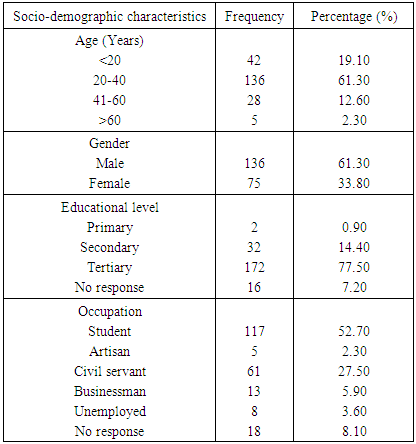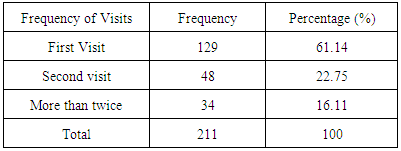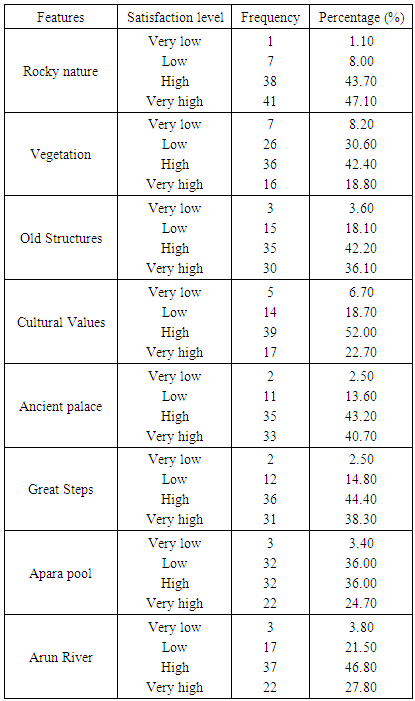-
Paper Information
- Paper Submission
-
Journal Information
- About This Journal
- Editorial Board
- Current Issue
- Archive
- Author Guidelines
- Contact Us
American Journal of Tourism Management
p-ISSN: 2326-0637 e-ISSN: 2326-0645
2016; 5(1): 1-8
doi:10.5923/j.tourism.20160501.01

Tourist Satisfaction with Attractions of Idanre Hills, Ondo State, Nigeria
Bukola O. Adetola1, Ifeoluwa B. Adewumi2, Henry T. Olonimoyo1
1Department of Ecotourism and Wildlife Management, Federal University of Technology, Akure, Nigeria
2Department of Wildlife and Ecotourism Management, University of Ibadan, Nigeria
Correspondence to: Ifeoluwa B. Adewumi, Department of Wildlife and Ecotourism Management, University of Ibadan, Nigeria.
| Email: |  |
Copyright © 2016 Scientific & Academic Publishing. All Rights Reserved.
This work is licensed under the Creative Commons Attribution International License (CC BY).
http://creativecommons.org/licenses/by/4.0/

Idanre hills has gain a lot of attention from government, researchers and volunteer groups since it was enlisted on the tentative list of the UNESCO World Heritage Site. Tourists’ satisfaction with the destination will not only affect their willingness to revisit but also the reputation of the destination. The study examined tourist satisfaction with their experience at Idanre Hills with the aim of determining their potential revisit and to make recommendations on strategies to enhance the destination’s competitive positioning. Administration of 250 questionnaires to tourists between December 2012 and May 2013 was used for data collection. Tourists’ satisfaction was measured using 4-point Likert scale format and Pearson’s Chi-square was used to test for the association between demographic characteristics and overall satisfaction with the study site. The result showed that 64.50% of the tourists sampled were between the ages of 20-40 years, with 57.40% students. It was observed that majority of the tourists were visiting for the first time and for the purpose of recreation. The overall satisfaction of the tourists with Idanre hills shows that about 87% of the tourists were generally satisfied with their experience, and 88% of the tourists were willing to revisit. The association between demographic characteristics and the overall satisfaction indicated that only the occupation of the tourists had a significant effect on their level of satisfaction (p<0.05). The need to innovatively improve the site by making all the attractions accessible to tourists will help in creating an image that appeals to more tourists.
Keywords: Idanre hills, Willingness to revisit, Tourists satisfaction
Cite this paper: Bukola O. Adetola, Ifeoluwa B. Adewumi, Henry T. Olonimoyo, Tourist Satisfaction with Attractions of Idanre Hills, Ondo State, Nigeria, American Journal of Tourism Management, Vol. 5 No. 1, 2016, pp. 1-8. doi: 10.5923/j.tourism.20160501.01.
Article Outline
1. Introduction
- The target and desire of any government is to develop their tourist industry because tourism can generate GDP, jobs [1], and a strong flow-through effect in other sectors such as retail, transportation, and construction [2]. In order to achieve this development, tourist satisfaction has to be a key factor for consideration [1]. Enhancing tourist satisfaction should be one of the primary functions of any tourism center [3-5] and a prerequisite for the development of a strategy leading to a destination’s enhanced attractiveness and its competitive positioning [6]. Tourism satisfaction is seen as a post-consumption evaluation of a chosen alternative cause of action to determine if it meets or exceeds expectations [7]. It is an emotional response derived from a consumption experience [8]; an individual’s cognitive–affective state derived from a consumer experience [9] or ‘a short-term emotional reaction to a specific service performance’ [10]. Tourists’ satisfaction are influenced by destination image, tourist expectation, and perceived value. Tourism destination image, which is an individual’s mental representation of the knowledge, feelings, and overall perception of a particular destination [1], has been frequently proven to have direct effect on tourist behaviour in terms of tourist expectation and perceived value [11]. Several dimensions relating to the tourist behaviours, such as their expectations and perception of value, are conditioned by the image that they have from the destination [12]. The expectations of the tourists are formed based on the image that they have from the destination before they travel [1]. A number of researchers have noted that tourist expectation directly affect both the perceived value and satisfaction [11], [13], [14]. The perceptions of tourists about a destination directly influences their satisfaction [1] because when they perceive that the quality of services given to them is greater than the money paid, the satisfaction is created [13], [15], [16]. Therefore, tourist satisfaction is created by the comparison of the pre-travel expectations and post-travel experiences [1], [16]. One of the crucial elements of successful destination marketing is tourist satisfaction, which influences the choice of destination and the decision to return [17]. It has been noted that understanding the nature and the antecedents of satisfaction are paramount [18]. The assessment of tourist satisfaction must be a basic parameter used to evaluate the performance of a destination and must play an important role in planning marketable tourism products and services for the destination [17].In recent years, tourist satisfaction has become an important research topic for both practitioners and academics [11] because satisfaction does not only affect immediate repeat purchases but also reputation [19] and trust [20]. Recognizing and understanding the cognitive and behavioural consequences of satisfaction has important implications for destination management [6]. Decision makers in the tourism sector should study the consequences of tourists’ satisfaction and dissatisfaction so as to provide themselves with adequate knowledge [1]. It has been posited that tourist dissatisfaction may lead to negative behaviour, which ultimately affects retention rates [21]. In a case of tourist dissatisfaction, customer recovery and complaint management becomes a priority [22]. Little or no assessments of tourists’ satisfaction have been conducted at Idanre Hills, which is one of the sites on the UNESCO World Heritage Site tentative list. Therefore, this study seeks to evaluate the satisfaction of tourists with the attractions visited because when tourists are satisfied, they tend to transmit their positive experience to others and repeat their visit [23], [24]. The objectives of this study are to assess tourists’ satisfaction levels of the various attractions sites visited and identify potential repeat visits to Idanre Hills.
2. Methodology
2.1. Study Area
- This study was carried out at the Idanre Hills, which is located in Idanre, Idanre Local Government Area of Ondo State, Nigeria (Figure 1). Idanre falls on latitude 9°8′N of the equator and Longitude 5°5′E of the Greenwich meridian with a terrain that stands at a height of 286 - 500m [25]. The Idanre Hills consists of high plains with spectacular valleys interspersed with inselbergs of about 3000 feet above sea level [26].
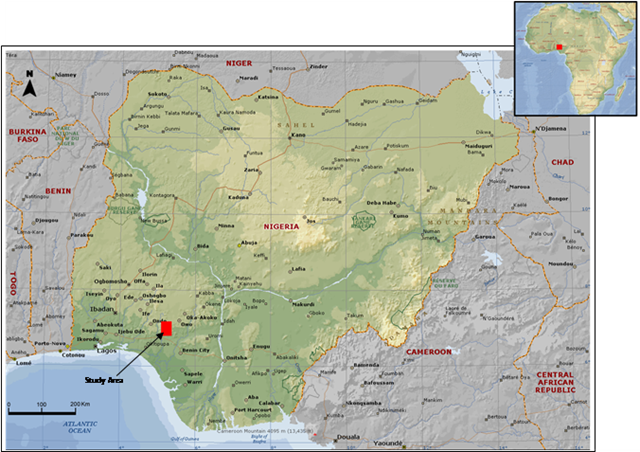 | Figure 1. Map of Nigeria showing the study site |
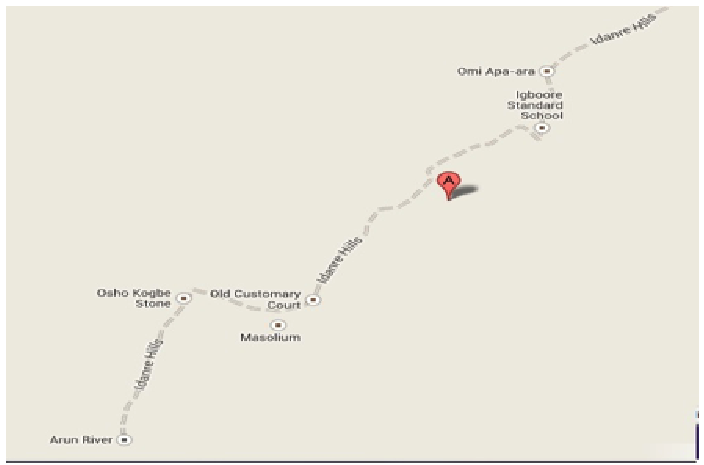 | Figure 2. Location of touristic features at the site |
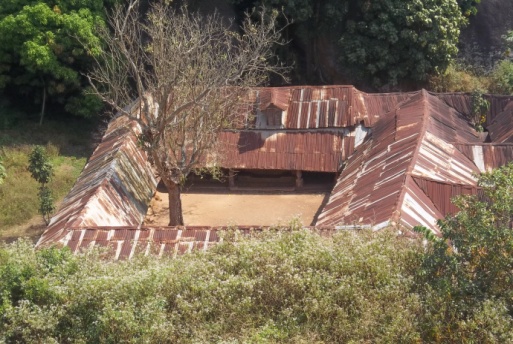 | Figure 3. Aerial view of the ancient Palace |
 | Figure 4. Dilapidated chalet |
 | Figure 5. The Agboogun footprint |
 | Figure 6. The unreadable letters on the rock |
2.2. Data Collection
- In studying tourist satisfaction with attractions at Idanre Hills, both secondary and primary data were gathered. Secondary data on the influx of tourist to Idanre Hills (2005 to 2012) was collected from the Ondo State Ministry of Culture and Tourism (Table 1). Primary data was collected using structured questionnaires to identify satisfaction level of visitors, which was considered in terms of visitors’ satisfaction with the various tourism attractions, overall site satisfaction and willingness to revisit. Some aspects of the questionnaire were designed using 4-point Likert scale format [30], with responses ranging from very low (1), low (2), high (3), very high (4). The questionnaires were randomly administered between December 2012 and May 2013 (festive/peak periods) to tourists that had already visited the site and were willing to fill and return them immediately. A total of 250 questionnaires were administered, with 211 properly filled and returned, accounting for 84.4% response rate.
|
3. Results
3.1. Socio-Demographic Characteristics of Respondents
- The socio-demographic characteristics of the surveyed tourists as shown in Table 2 indicate that respondents between the ages of 20-40 years constituted the largest number of tourists with the majority of the respondents being male and students with only a few percentage of the tourists being unemployed (3.90%).
|
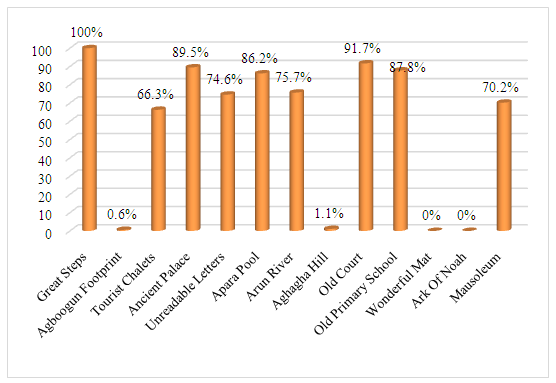 | Figure 7. Idanre hill attractions visited by tourists |
3.2. Frequency of Visits and Purpose of Respondents’ Visit
- The result revealed that over 61% of the tourists were visiting the destination for the very first time with a few of the respondents visiting for a second time (Table 3). It was discovered from the study that the main purpose of visit was for recreation while some of the tourists visited the site for educational, research, cultural festivals purposes, with only one of the tourists visiting for work purpose (Table 4).
|
|
3.3. Satisfaction Level of Tourists and Willingness to Revisit
- As seen in Table 5, satisfaction level of the tourists with the rocky nature of Idanre Hills and Ancient palace were very high, while satisfaction level were relatively high with the cultural values, old structures, Arun River, and vegetation of the site. It was observed that Apara pool recorded the highest percentage of low satisfaction level. The result of the overall satisfaction level of the tourists with Idanre Hills revealed that majority of the tourists surveyed were satisfied with their experiences at destination (Figure 8), but a few (13%) were dissatisfied.
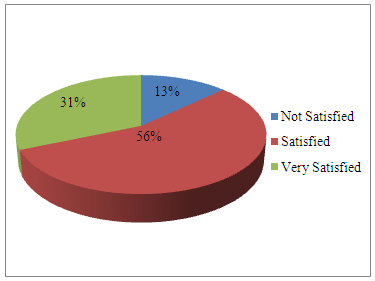 | Figure 8. Overall Site Satisfaction |
|
|
 | Figure 9. Willingness to revisit |
4. Discussion
- The findings of the demographic characteristics of the respondents show that a higher percentage of the tourists are between the ages of 20 and 40 years, with the older people less represented. This is quite similar to the finding of Ogunbodede, who observed that majority of the tourists to Idanre hills were within the ages of 21 and 40 [25]. He explained that this age group constitute the economically viable set of people who can afford to spend money on tourism, and those that are physically strong to climb the great steps. In order to encourage tourists that are not physically fit to climb the steps, it is recommended that the introduction of cableways or elevators may make it easier for them to visit the features at the destination. The high percentage of tourist that are single suggests that unmarried people are more involved in tourism, which might be due to the fact that they are freer and have no marital commitment to hamper their interest in participating in tourism. It was also discovered that almost all the respondents are educated with 77.5% of them having tertiary education, suggesting that majority of the tourists to this site are aware of and understand the importance of tourism. This is in line with a previous study where the majority of tourists to Idanre hills were single and are students of or have finished from tertiary institutions [25]. The study revealed that the old court, ancient palace and the old primary school were mostly visited, with Agboogun footprint and Aghagha hill rarely visited. The ark of Noah and wonderful mat were not visited at all by any of the tourists sampled. Rare visit to these attractions might have been because they are quite far from other attractions and not easily accessible. Lack of accommodation facilities on the hill might have also contributed to the low number of visits /or non-visit of these sites, because the attractions are widely distributed on the hill and would be difficult to visit all in one day. Tourist might have visited these sites if they have had a place to stay overnight on the hill. In addition, inadequate interpretative signs and tour guides to direct the tourists to these attractions might have also contributed to the low influx of tourists to the attractions. There is need to make all the attraction at Idanre hills accessible to tourists so as to diversify the tourists’ products and relieve pressure on the attractions mostly visited by dispersing the tourists throughout the available resources.It was discovered that a great number of the tourists were visiting for the first time. This might be due to the increase in publicity of the site resulting from its inclusion on the UNESCO World Heritage Site Tentative List [31], [32]. Since the inclusion of the site on the tentative list, the Ondo state tourism board andvarious volunteer groups have helped with the publicity of the site, resulting to the increase in awareness, leading to an increase in the number of tourists visiting the site for the first time. It was also observed that 38.86% of the respondents were repeating their visit. This repeated visit might have been as a result of their satisfaction during their previous visit or because they did not visit all the attraction during the previous visit. It has been noted that tourist satisfaction influences their decision to return [17], while some argued that the perceived attraction of a destination could influence repeat visitations [33].The purpose of visit to Idanre Hills by most of the tourists (72.99%) is for recreation while education and research purposes accounted for 7.58% and 5.69% respectively. In a research carried out at the study site in 2013, majority of the respondents visited Idanre Hills for recreational purpose followed by education and research respectively [34]. Many tourists might have come to Idanre hills for recreation purpose because the site has been recommended as a high-ranking resort centre due to the natural and cultural features of Idanre Hills [25]. Some of the respondents also came to the site for educational and research purposes because little researches have been carried out on the site in various fields like Geography, Environmental sciences, history among others.The overall satisfaction level of the respondents reveal that majority of them (87%) were generally satisfied with their experience at the Idanre Hills. Their satisfaction might be because they perceived that their experience at the site met their expectation and perceived values of the site [14], [11], which is more than the money paid[13], [16]. It has been proven that tourists’ satisfaction is directly influenced by their perception [1]. The high percentage of respondents willing to revisit (88%) might be as a result of their satisfaction with their experience or because they were unable to visit all the attractions during this visit. Some researchers are of the opinion that satisfied tourists tend to repeat their visit and transmit their positive experience to others [23], [24]. Tourist satisfaction influences their choice of destination and the decision to return [17], which is one contributing factor to destination loyalty intention [35]. Therefore, enhancing tourists’ satisfaction is a prerequisite for the development of strategy leading to a destination’s enhanced attractiveness and its competitive positioning [6].The relationship between the demographic characteristics of the tourists and their satisfaction reveals that age, gender and educational level had no significant effect on the satisfaction level of the tourists. It was observed that the occupational status of respondents had a significant effect on satisfaction of tourists to the site. In various studies, overall satisfactions of the respondents were significantly different based on gender of the respondents [36] and tourists educational levels [37]. In a study of factors determining tourists’ satisfaction, it was discovered that the probability of answering “satisfied” increased with the level of education completed, while there was no difference in satisfaction due to occupation [38]. It can therefore be inferred from these various findings that the satisfaction levels of tourists depend on various demographic characteristics in different tourist destination.
5. Conclusions
- The study has contributed to literature by providing a general picture of the level of satisfaction of tourists to Idanre Hills. It is evident from the finding that Idanre Hill attracts the younger generation of tourists. It is necessary to sustain the satisfaction of this group of tourist because they are economically viable to spend money on tourism. High level of satisfaction was observed amongst the tourists’ notwithstanding, some of the attractions at Idanre Hills such as Agboogun footprint, wonderful mat and Ark of Noah were rarely visited. The high level of satisfaction of the tourists with their experience has influenced their willingness to revisit, which will invariably influence the reputation of the destination. The findings of this study should be of interest to the government and other industries considering tourism-development and marketing of Idanre Hills because tourist satisfaction is one of the crucial elements of successful destination marketing, which also influences the choice of destination and the decision to return. To improve and sustain the satisfaction with the destination, it is necessary to diversify the tourism products of Idanre hills by making all its attractions accessible to tourists. Innovatively improving the site will help in creating an image that appeals to more tourists and establish stronger loyalties that will manifest through repeat visits and recommendations to others. The management of Idanre hills should examine how to strengthen the image of the site, enhance loyalty, and fortify emotional connections between tourists and the destination. Provision of comfortable accommodations, good signage and tour guides are recommended as some improvements needed to enable the tourists visit all the attractions and stay longer at the site. Although the study reveals the association between the demographic characteristics of the tourist and their satisfaction level, the study however, did not mention the relationship between tourist satisfaction and their purpose of visiting and willingness to revisit. Future research should investigate the relationship between tourists’ satisfaction and intention to revisit the destination.
 Abstract
Abstract Reference
Reference Full-Text PDF
Full-Text PDF Full-text HTML
Full-text HTML
